|
|
|
Sort Order |
|
|
|
Items / Page
|
|
|
|
|
|
|
| Srl | Item |
| 1 |
ID:
160093
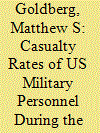

|
|
|
|
|
| Summary/Abstract |
In Operation Iraqi Freedom, which ended in August 2010, nearly 3500 hostile deaths occurred among US military personnel and 32,000 more were wounded in action (WIA). More than 1800 hostile deaths occurred during Operation Enduring Freedom (in and around Afghanistan) through 2014 and about 20,000 were WIA. A larger proportion of wounded personnel survived in Iraq and Afghanistan than during the Vietnam War, but the increased survival rates were not as high as some studies have asserted. The survival rates were 90.2% in Iraq and 91.6% in Afghanistan, compared with 86.5% in Vietnam. The casualty rates varied between the conflicts in Iraq and Afghanistan and before, during, and after the respective surges. Amputation rates are difficult to measure consistently, but I estimate that 2.6% of all WIA and 9.0% of medically evacuated WIA from the Iraq and Afghanistan theaters combined resulted in the major loss of a limb. Elevated non-hostile death rates (including deaths due to accidents, illnesses, homicides, or suicides) resulted in about 220 more deaths in Iraq and about 200 more deaths in Afghanistan than would have been expected in peacetime among populations of the size deployed to those two conflicts.
|
|
|
|
|
|
|
|
|
|
|
|
|
|
|
|
| 2 |
ID:
182854
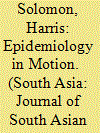

|
|
|
|
|
| Summary/Abstract |
This paper is an ethnographic account of traumatic brain injuries (TBIs) based on a study of a public hospital trauma ward in urban India. It explores the contexts, causes and consequences of TBIs in order to make several broader claims. Across two case studies, I argue that epidemiological transitions towards non-infectious disease regimens must be understood as problems of somatic movement. The implication is that bodies make transitions through actual and imagined changes in bodily movements that define how persons become patients, how traumatic injury pulls on clinical resources, and how differences in gender, sexuality, class and caste affect the social dynamics of brain injury in urban settings at every turn.
|
|
|
|
|
|
|
|
|
|
|
|
|
|
|
|
| 3 |
ID:
169835
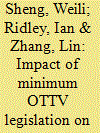

|
|
|
|
|
| Summary/Abstract |
As a measure of building envelope performance, Overall Thermal Transfer Value (OTTV) has been regulated in many countries and regions in the world, while little research is done to evaluate its city-scale effect with energy consumption. In this paper, we develop an econometric energy epidemiology model to evaluate the impact of OTTV legislations on electricity consumption using Hong Kong as an example, as Hong Kong government is one of the first adopters of OTTV regulation. For this purpose, we construct a unique database on the energy consumption of residential and commercial buildings in Hong Kong, including 39092 buildings from 1982 to 2016. Noticeable contributions to the total building energy saving could be found from historical OTTV legislations by 2016. As predicted by the model, in 2030, the annual electricity reduction can reach approximately 20000TJ without further regulation amendment, which is an important support to the “HK3030” energy target.
|
|
|
|
|
|
|
|
|
|
|
|
|
|
|
|
| 4 |
ID:
174252


|
|
|
|
|
| Summary/Abstract |
This introductory essay contextualizes the special collection of papers on the pandemic and seeks to map the terrain of extant public health research on Palestine and the Palestinians. In addition, it is a contribution in Palestine studies to a nascent yet propulsive conversation that has been accelerated by Covid-19 on the erasure of structures of violence, including those of settler colonialism and racial capitalism, within the discipline of epidemiology. Using public health as an analytic, this essay asks us to consider foundational questions that have long been sidelined in the public health discourse on Palestine, including the implications for health and health research of eliding ongoing settler colonialism. Rather than ignoring and reproducing their violence, this essay seeks to tackle these questions head-on in an attempt to imagine a future public health research agenda that centers health, and not simply survivability, for all Palestinians.
|
|
|
|
|
|
|
|
|
|
|
|
|
|
|
|
| 5 |
ID:
108430


|
|
|
|
|
| Publication |
2011.
|
| Summary/Abstract |
Two epidemic modeling studies of inhalational tularemia were identified in the published literature, both demonstrating the high number of potential casualties that could result from a deliberate aerosolized release of the causative agent in an urban setting. However, neither study analyzed the natural history of inhalational tularemia nor modeled the relative merits of different mitigation strategies. We first analyzed publicly available human/primate experimental data and reports of naturally acquired inhalational tularemia cases to better understand the epidemiology of the disease. We then simulated an aerosolized release of the causative agent, using airborne dispersion modeling to demonstrate the potential number of casualties and the extent of their spatial distribution. Finally, we developed a public health intervention model that compares 2 mitigation strategies: targeting antibiotics at symptomatic individuals with or without mass distribution of antibiotics to potentially infected individuals. An antibiotic stockpile that is sufficient to capture all areas where symptomatic individuals were infected is likely to save more lives than treating symptomatic individuals alone, providing antibiotics can be distributed rapidly and their uptake is high. However, with smaller stockpiles, a strategy of treating symptomatic individuals alone is likely to save many more lives than additional mass distribution of antibiotics to potentially infected individuals. The spatial distribution of symptomatic individuals is unlikely to coincide exactly with the path of the dispersion cloud if such individuals are infected near their work locations but then seek treatment close to their homes. The optimal mitigation strategy will depend critically on the size of the release relative to the stockpile level and the effectiveness of treatment relative to the speed at which antibiotics can be distributed.
|
|
|
|
|
|
|
|
|
|
|
|
|
|
|
|
| 6 |
ID:
169934
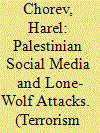

|
|
|
|
|
| Summary/Abstract |
This article examines the impact of social media on the wave of Palestinian lone-wolf attacks against Israelis from October 2015 through September 2016. My principal argument is that social media played an important role in shaping the identity, perceptions, and behavioral patterns of dozens of assailants, and was key in creating the dynamic that ultimately characterized both the spreading of the idea of lone-wolf attacks and its execution. Social media reflected reality on the ground while simultaneously nourishing, amplifying, and escalating the situation by providing a platform for the emergence of new sources of authority, including an online subculture with distinct codes and pseudo-ritual patterns to support assailants. Social media also contributed substantially to shaping the contagious character of the attacks, and their capacity to persist without direct organizational guidance, following a typical epidemiological dynamic of spread, containment, and preservation.
|
|
|
|
|
|
|
|
|
|
|
|
|
|
|
|
| 7 |
ID:
090962


|
|
|
|
|
| Publication |
2009.
|
| Summary/Abstract |
As constructivists and other advocates of constitutive theories have often noted, the natural world is very different from the social one. Our ideas about the social world not only reflect that world, but help shape and create it; we are part of the reality we try to describe and explain, and we therefore have the potential to alter the reality a theory is merely intended to describe or explain. Our theories about the social world may thus become self-fulfilling prophecies or autogenetic in character, or they may self-negate. And yet while social constructivists often make this point in epistemological debates, there have been relatively few attempts so far to address its empirical implications. With that objective in mind, this paper examines two prominent IR theories-the democratic peace and the commercial peace-arguing that each has a self-fulfilling character rather than being true or false in any objective or timeless sense, as well as the potential of a currently self-negating thesis-the clash of civilizations-to become self-fulfilling; each theory is, to paraphrase the now time-honored expression, what the relevant actors make of it. The article also probes the processes by which theories become self-generating or self-negating. It is suggested that a number of frameworks developed outside political science-especially diffusion theory, memetics, social contagion theories, George Lakoff's metaphor-based model, Malcolm Gladwell's "Tipping Point" approach and social network analysis-may in combination help us understand both how political ideas spread through academic and policy communities and why particular ideas "win out" over others.
|
|
|
|
|
|
|
|
|
|
|
|
|
|
|
|
| 8 |
ID:
124717
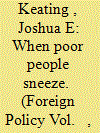

|
|
|
|
|
| Publication |
2013.
|
| Summary/Abstract |
Analysts often borrow from the vocabulary of disease to describe financial crises, using word such as "pandemic" and "contagion" to discussed how economic disturbance spread. But recent research suggests a more literal connection between the two : poor countries, actual disease can infect the financial system.
|
|
|
|
|
|
|
|
|
|
|
|
|
|
|
|
|
|
|
|
|